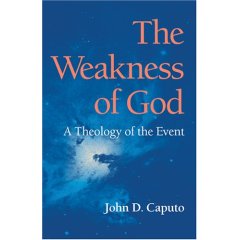ok, this is totally off topic, but it had me crying from laughter at my desk.
Hi folks.
I’m knee-deep into John D. Caputo’s first officially theological endeavor, The Weakness of God: A Theology of the Event and it’s having rather significant influence on both my conception of God and my conception of art (in a really indirect way).
My more traditionally orthodox and theologically conservative friends will want to throw me out with the liberal bathwater they might associate with Caputo’s arguments (although I’d urge them not to rely on reviews, but read it for themselves, thank you very much) but I’m really finding the exploration of St. Paul’s writing in I Corinthians to be fascinating. Caputo essentially launches his theology from this:
“but we preach Christ crucified, to Jews a stumbling block and to Gentiles foolishness, but to those who are the called, both Jews and Greeks, Christ the power of God and the wisdom of God. Because the foolishness of God is wiser than men, and the weakness of God is stronger than men.”
1 Corinthians 1:23-25 (New American Standard Bible)
Obviously, my summarizing is drastically simplistic, but the idea of God moving and working in and through human weakness rather than with a sort of “shock and awe” strength is something I’ve heard preached many times and that has really contradicted other notions tauting God’s omnipotence. Red flags go up. He’s messing with God’s omnipotence! Wait, he also argues rather convincingly that said omnipotence is a later, human, metaphysical assertion that isn’t consistent with a hebraic and logical interpretation of the bible. woah. Lest the torches are lit prematurely, I’ll let you know that Caputo neither approaches his argument lightly, nor does he point us away from our faith in God, rather, he seems to be pointing us more directly to the God who moves us to both do and be the good that He created – exemplified in Jesus Christ on the cross (ha! and you thought you could write it off so easily).
But what does my mid-point in a theology tome have to do with paintings in Chelsea?
I’m still working that out, but it seems to have profound implications for the motivation of the artist and the product the artist creates. If a person postures themselves in proximity to a deity that advocates for the weak, the lowly, the poor, then the art that comes out must, at least partially, reflect similar notions.
A theology of weakness begets an aesthetic of weakness.
…and that’s where I’m at – finishing the book and looking for others that might inform a research into an aesthetic of weakness.
Some people have suggested Richard Kearney – who seems to be working on it through the idea of stories.
Let’s see where it goes.
(See you at church)
PAX
-W


As an artist/inteligencia/demi god type, I conceder Museums, Galleries, Theaters to be Church. As a writer/thinker type coffee shops, computers and nights at home are Church… So, I worship regularly in the art of making and thoughts of creating… Yet the actual Churches are cool too.
That’s probably a more reasonable view of church than most of the people I grew up around have. The world is our place to experience God, sometimes that can also happen in church.